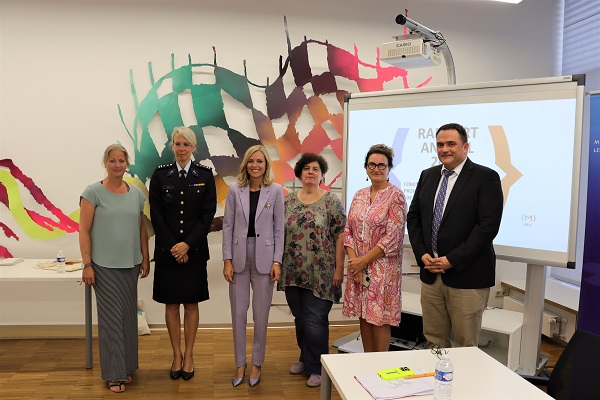 (L-R) Laurence Bouquet, Riicht Eraus; Kristin Schmit, Grand Ducal Police; Taina Bofferding, Minister of Equality Between Women & Men; Olga Strasser, SAVVD; Maryse Fisch, Ministry of Equality; Laurent Seck, prosecutor at Luxembourg District Court;
Credit: MEGA
(L-R) Laurence Bouquet, Riicht Eraus; Kristin Schmit, Grand Ducal Police; Taina Bofferding, Minister of Equality Between Women & Men; Olga Strasser, SAVVD; Maryse Fisch, Ministry of Equality; Laurent Seck, prosecutor at Luxembourg District Court;
Credit: MEGA
On Wednesday 21 June 2023, Luxembourg's Minister of Equality between Women and Men, Taina Bofferding, presented the 2022 report of the committee for cooperation between professionals in the field of combating violence.
According to this report, domestic violence remains a daily reality in Luxembourg, despite the efforts made over the past 20 years, i.e. since the entry into force of legislation facilitating the eviction of perpetrators from the home. Luxembourg's Ministry of Equality between Women and Men described the committee for cooperation between professionals in the field of combating violence as one of the cornerstones of the system in place to support anyone who is the victim of violence, who has recourse to violence or who witnesses violence.
This latest report contains statistics on domestic violence as presented by the various bodies represented on the committee, namely the prosecutor's office at the district courts of Luxembourg and Diekirch, the Grand Ducal Police, assistance services for victims of domestic violence (SAVVD, PSYea and ALTERNATIVES) as well as the service for perpetrators of domestic violence (Riicht Eraus).
In 2022, the Grand Ducal Police intervened in 983 cases related to domestic violence, which represents an increase of 7.2% compared to 2021 (917). The number of evictions authorised by the prosecution was 246 (249 in 2021) - a decrease of 1.2%. On average, officers intervened 81.9 times (76.4 in 2021) and carried out 20.5 evictions (20.8 in 2021) per month.
Moreover, the number of victims listed in the context of police interventions is on the rise: this figure stood at 1,712 in 2021, but increased by 120 to 1,832 in 2022.
60% of victims were female (60.7% in 2021) and 40% were male (39.3% in 2021). 463 victims were minors, compared to 389 in 2021. The 35-40, 40-45 and 50+ age groups were the most affected and together represented 31.66% of all victims, according to the report.
The number of perpetrators of domestic violence also increased over one year: in 2022, the Grand Ducal Police identified 1,385 perpetrators, i.e. an increase of 1.5% compared to 2021.
68.7% of perpetrators were male (67.7% in 2021) and 31.3% were female (32.3% in 2021). 2.67% of perpetrators were minors and were placed through a temporary custody measure according to the applicable law. Most perpetrators fell into the 30-35, 35-40 and 40-45 age groups, which together represented 43.75%.
"The increase in the number of police interventions confirms that domestic violence is no longer considered a private matter and that more people affected are showing bravery and calling the police," commented Minister Bofferding. "This is also the message that my teams and professionals in the field constantly repeat during awareness-raising actions aimed at the general public: not (re)acting is the worst option!”
In 2022, the Luxembourg and Diekirch prosecutor's offices responded to 1,489 cases of domestic violence - compared to 983 police interventions. According to the ministry, this difference of 506 cases results from the consideration by the public prosecutor's office of other offences beyond article 409 of the Penal Code in relation to domestic violence.
In 2022, the SAVVD assistance service for domestic violence victims carried out a total of 300 consultations and 3,292 telephone calls to assist victims in the context of the 246 eviction cases communicated to the service on the basis of the 2003 amended law on domestic violence.
The Riicht Eraus counselling service for perpetrators of domestic violence carried out a total of 1,834 consultations in the context of evictions and other channels.
In light of these figures, Minister Bofferding emphasised that "over 20 years, Luxembourg has built up an efficient system for the fight against domestic violence". She elaborated: "Today, domestic violence is no longer a fatality but is recognised as a societal problem and it is important that every single victim receives help. Victim protection is and remains our priority." She stressed the need to strengthen the legal framework in place, risk analyses and an adapted sentence depending on the profile of the offender and cooperation between victim protection and working on reducing the number of offenders.








